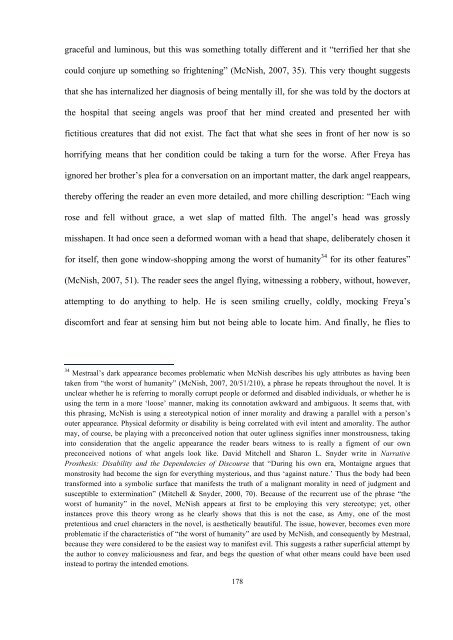The secular angel in contemporary children's literature: David ...
The secular angel in contemporary children's literature: David ...
The secular angel in contemporary children's literature: David ...
You also want an ePaper? Increase the reach of your titles
YUMPU automatically turns print PDFs into web optimized ePapers that Google loves.
graceful and lum<strong>in</strong>ous, but this was someth<strong>in</strong>g totally different and it “terrified her that she<br />
could conjure up someth<strong>in</strong>g so frighten<strong>in</strong>g” (McNish, 2007, 35). This very thought suggests<br />
that she has <strong>in</strong>ternalized her diagnosis of be<strong>in</strong>g mentally ill, for she was told by the doctors at<br />
the hospital that see<strong>in</strong>g <strong>angel</strong>s was proof that her m<strong>in</strong>d created and presented her with<br />
fictitious creatures that did not exist. <strong>The</strong> fact that what she sees <strong>in</strong> front of her now is so<br />
horrify<strong>in</strong>g means that her condition could be tak<strong>in</strong>g a turn for the worse. After Freya has<br />
ignored her brother’s plea for a conversation on an important matter, the dark <strong>angel</strong> reappears,<br />
thereby offer<strong>in</strong>g the reader an even more detailed, and more chill<strong>in</strong>g description: “Each w<strong>in</strong>g<br />
rose and fell without grace, a wet slap of matted filth. <strong>The</strong> <strong>angel</strong>’s head was grossly<br />
misshapen. It had once seen a deformed woman with a head that shape, deliberately chosen it<br />
for itself, then gone w<strong>in</strong>dow-shopp<strong>in</strong>g among the worst of humanity 34 for its other features”<br />
(McNish, 2007, 51). <strong>The</strong> reader sees the <strong>angel</strong> fly<strong>in</strong>g, witness<strong>in</strong>g a robbery, without, however,<br />
attempt<strong>in</strong>g to do anyth<strong>in</strong>g to help. He is seen smil<strong>in</strong>g cruelly, coldly, mock<strong>in</strong>g Freya’s<br />
discomfort and fear at sens<strong>in</strong>g him but not be<strong>in</strong>g able to locate him. And f<strong>in</strong>ally, he flies to<br />
34 Mestraal’s dark appearance becomes problematic when McNish describes his ugly attributes as hav<strong>in</strong>g been<br />
taken from “the worst of humanity” (McNish, 2007, 20/51/210), a phrase he repeats throughout the novel. It is<br />
unclear whether he is referr<strong>in</strong>g to morally corrupt people or deformed and disabled <strong>in</strong>dividuals, or whether he is<br />
us<strong>in</strong>g the term <strong>in</strong> a more ‘loose’ manner, mak<strong>in</strong>g its connotation awkward and ambiguous. It seems that, with<br />
this phras<strong>in</strong>g, McNish is us<strong>in</strong>g a stereotypical notion of <strong>in</strong>ner morality and draw<strong>in</strong>g a parallel with a person’s<br />
outer appearance. Physical deformity or disability is be<strong>in</strong>g correlated with evil <strong>in</strong>tent and amorality. <strong>The</strong> author<br />
may, of course, be play<strong>in</strong>g with a preconceived notion that outer ugl<strong>in</strong>ess signifies <strong>in</strong>ner monstrousness, tak<strong>in</strong>g<br />
<strong>in</strong>to consideration that the <strong>angel</strong>ic appearance the reader bears witness to is really a figment of our own<br />
preconceived notions of what <strong>angel</strong>s look like. <strong>David</strong> Mitchell and Sharon L. Snyder write <strong>in</strong> Narrative<br />
Prosthesis: Disability and the Dependencies of Discourse that “Dur<strong>in</strong>g his own era, Montaigne argues that<br />
monstrosity had become the sign for everyth<strong>in</strong>g mysterious, and thus ‘aga<strong>in</strong>st nature.’ Thus the body had been<br />
transformed <strong>in</strong>to a symbolic surface that manifests the truth of a malignant morality <strong>in</strong> need of judgment and<br />
susceptible to exterm<strong>in</strong>ation” (Mitchell & Snyder, 2000, 70). Because of the recurrent use of the phrase “the<br />
worst of humanity” <strong>in</strong> the novel, McNish appears at first to be employ<strong>in</strong>g this very stereotype; yet, other<br />
<strong>in</strong>stances prove this theory wrong as he clearly shows that this is not the case, as Amy, one of the most<br />
pretentious and cruel characters <strong>in</strong> the novel, is aesthetically beautiful. <strong>The</strong> issue, however, becomes even more<br />
problematic if the characteristics of “the worst of humanity” are used by McNish, and consequently by Mestraal,<br />
because they were considered to be the easiest way to manifest evil. This suggests a rather superficial attempt by<br />
the author to convey maliciousness and fear, and begs the question of what other means could have been used<br />
<strong>in</strong>stead to portray the <strong>in</strong>tended emotions.<br />
178
















